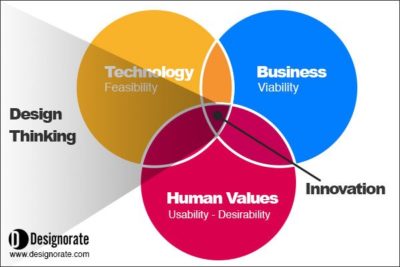Apple’s history with innovation provides a clear lesson about how design and innovation can turn company failure to market success and a leading position in a competitive market. Design thinking helped Apple to innovate while placing their consumers at the heart of the process.
Origen: Designorate – Design Thinking Case Study: Innovation at Apple

In the period 1985-1997, Apple struggled to achieve market success, especially after Jobs’s departure and increasing competition from other giants such as IBM, which decided to enter the PC computers market. During this period, Apple faced number of challenges including:
- Unstable strategy due to the change of executive teams
- Unclear vision about Apple’s competitive strategy, especially after IBM entered the PC market
- Unclear vision about selling OS licenses, which would put the company in competition with Windows operating system
- Large number of failed products (such as Newton PDA) and few successful ones (such as PowerBook)
- Products not unique in the market
- Confusion and uncertainty among Apple consumers, resulting from this strategy
Apple is one of the leading companies in the field of innovation and this couldn’t have happened without the company adopting design thinking. Design thinking is a solution-oriented process that is used to achieve innovation with considerations about the consumer at the heart of all development stages. Tim Brown, president and CEO of IDEO, defines design thinking as follows: “Design thinking is a human-centered approach to innovation that draws from the designer’s toolkit to integrate the needs of people, the possibilities of technology, and the requirements for business success.”
“Most people make the mistake of thinking design is what it looks like. People think it’s this veneer — that the designers are handed this box and told, ‘Make it look good!’ That’s not what we think design is. It’s not just what it looks like and feels like. Design is how it works.” — Steve Jobs
After Steve Jobs returned to Apple in 1997 (upon Apple’s acquisition NeXT), he started to apply the design thinking characteristics discussed above, which reflected his vision for Apple products. The vision discussed below was used to form Apple’s strategy from 1997 until today. Steve Jobs applied design thinking by focusing on:
- People’s needs and desires, rather than only the needs of the business
- Building empathy by helping people to love Apple products
- The design rather than the engineering work; designers consider both the form and the function of the product
- Building simple yet user-friendly products rather than complex hard-to-use products
The vision characterized above can be clearly identified in modern Apple products. Although other competitors focus on the features and product capabilities, Apple focuses on a holistic user experience. For example, the iMac is renowned for being quiet, having a quick wake-up, better sound, and a high-quality display. This vision was formed in Apple’s development strategy that includes:
- Excellence in Execution
- Platform Strategy
- Iterative Customer Involvement
- Beautiful Products
